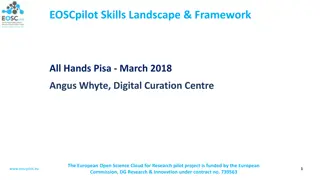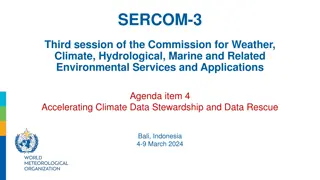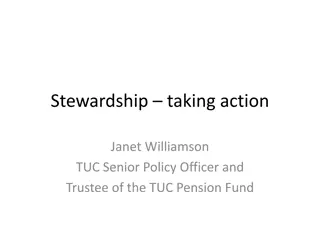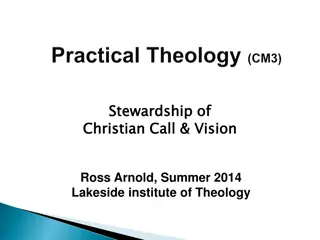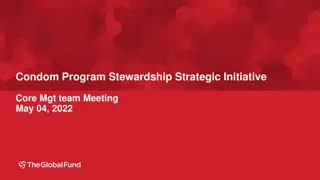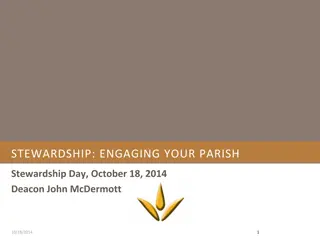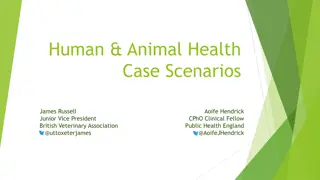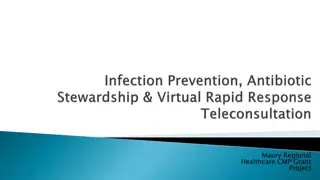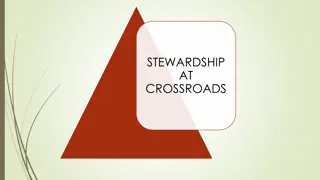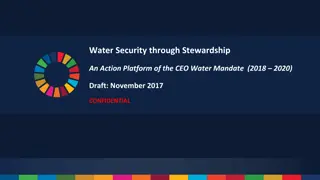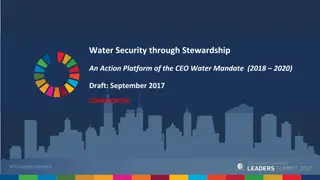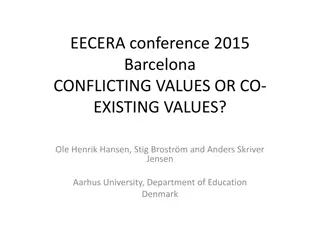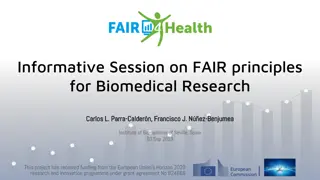Understanding Stewardship in Student Affairs: Principles and Values
Stewardship in Student Affairs involves effective management and safeguarding of resources like time, money, and people. This session delves into the principles of stewardship, rooted in priorities and values, emphasizing transparency, accountability, and adaptability. It also highlights the Division of Student Affairs' vision, mission, and core values of integrity, social justice, innovation, and collaboration.
Download Presentation

Please find below an Image/Link to download the presentation.
The content on the website is provided AS IS for your information and personal use only. It may not be sold, licensed, or shared on other websites without obtaining consent from the author. Download presentation by click this link. If you encounter any issues during the download, it is possible that the publisher has removed the file from their server.
E N D
Presentation Transcript
SESSION 3: STEWARDSHIP Julie Payne-Kirchmeier Vice President for Student Affairs April 21, 2021
Budget 101 Part 3 What is Stewardship? Priorities and Processes Stewardship of Division of Student Affairs Budget Our Role Questions and Discussion
Stewardship Stewardship Effective management and safeguarding of another s resources. Resources include time, money, technology, people, and property. Financial Stewardship Managing, allocating, garnering, and spending financial resources wisely. Division Stewardship Value Statement We strive to be thoughtful and responsible with our natural and institutional resources, facilities, and spaces
5 Principles of Stewardship 1. Rooted in priorities and values 2. Comprehensive and based on the best available information, while acknowledging future uncertainties. 3. Planning and decision making are transparent and responsive to input. 4. Incorporates monitoring and continuous learning, and is adaptive to new information. 5. Utilizes accountability for outcomes.
Student Affairs Vision: We will be full partners in the student learning experience. Mission: The Division of Student Affairs will educate students, engage the community, and enrich the Northwestern Experience. 9
Division Values Integrity We exercise the highest ethical and professional standards in our advancement of the student learning experience and in relationships with community and external partners. Social Justice We commit ourselves to creating a Northwestern community that facilitates full and equal access to learning in and outside the classroom. We assess our programs, services, and institutional climate to contribute to an equitable and inclusive Northwestern experience. Innovation We look for creative and sustainable approaches to enhance our work, challenge assumptions, and promote strategies to advance student learning and success. We inspire and are inspired; we infuse energy and passion into the pursuit of our vision and mission. Collaboration We practice open, authentic, and civil communication. We seek first to understand. We partner with one another, students, faculty, staff, alumni, and community members in a collegial manner that is consistently professional, respectful, and empathic. Stewardship We strive to be thoughtful and responsible with our natural and institutional resources, facilities, and spaces.
Priorities Crosswalk University Priority Maintain health and safety of our community; Support student experience Alignment of Division Priorities FY19-FY21 Expand upon existing student wellness programs while delivering services and influencing policies that promote mental, physical, and emotional health, resilience, and wellbeing Leverage the two-year live-on requirement as a conduit to continue building community on campus. Strategic Theme Student Wellness Social Justice Student Learning Enrich Community Organizational Health Social Justice Enrich Community Student Learning Student Wellness Enrich Community Organizational Health Student Wellness Commitments to Social Justice; Support Student Experience Collectively impact the campus climate for diversity, equity and inclusion with emphasis on first generation, low-income, and marginalized students. Ensure students develop an integrated sense of personal identity, self-efficacy, and a personal code of ethics; and develop healthy, respectful, and collaborative relationships with others. Contribute to the university's comprehensive 7-year strategy to enhance facilities and spaces for students. Restoring Support for basic infrastructure Strengthen Faculty and Staff Compensation Pool Focus on organizational health and workforce planning as supported by the division's new human resources strategy.
Transparency Monthly reporting for leaders in Tableau Monthly roll up reporting and review for JPK Budget 101 Series Process outline and overview university and division
Fiscal Planning Cycle Strategy Preparation and Meeting Fiscal Year-End Close Resource Planning Budget Preparation for next FY Performance Excellence and Compensation
FY 2022 Budget Preparation Nov. 2020 November Resource Planning letter from Central*** December - January Strategy Document developed and budget priorities identified*** Late January/Early February SA Three-year Strategy presentation to Senior Leadership March April - FY22 Resource Planning with units*** Early May Budget Office provides the preliminary management budget to the division May June Departmental budget meetings with SABF and SALT leads/teams; budget reallocations to reflect reorganizations; compensation planning *** July - SABF input budgets in NUPlans Mid-Late August - FY 22 Budgets available to view in NUFinancials*** September 1, 2021 FY22 Fiscal Year Live October Budget Adjustment Period We are here Oct. 2021
Accountability Job Descriptions Performance Excellence process Monthly reporting for leaders in Tableau Monthly roll up reporting and review for JPK Regular meetings with SALT leads and Business and Finance Quarterly roll up of full division budgets also aligns with submitting quarterly projections to Central budgeting Connection with priorities during budget allocation
Challenges 1. Thinking only short term or long term 2. Lack of direction or process 3. Priorities and/or values come in conflict with one another (tensions) 4. Priorities between units and the division, or the division and the university, are not aligned 5. Priorities/needs shift once resources have been allocated 6. Changing leadership at key senior levels at Northwestern, and internal to the division. 7. Conflating priority, urgency, emergency, and crisis 8. Not enough resources to fully address priorities
Caveats and Context Budget Reductions Merit Increase to be covered by SA Inconsistent processes year over year Changing leadership COVID-19 Racial equity and social justice
Scenario 1 You are the director of a unit in Student Affairs. Your department is facing a budget cutback mid-year due to some unforeseen cost overruns in key areas. You are looking at ways to navigate the cutback, and have asked the leadership team to identify ways to preserve financial resources. After a full vetting of the budget, you re stuck. One of your team members offered up a solution about cutting back on food at events with staff; A second team member countered by saying that s too important for organizational health . A third team member pointed out that removing refreshments at meetings, instead of full meals/food at events, could be a way to preserve resources. You need to make a decision. What do you do?
Scenario 1 As the director in this unit, what is your decision? A. Keep the food. Organizational health is the most important thing. You ll find something else to cut. B. Eliminate all food at events and meetings for staff. Focusing on our students is the most important thing. C. Find an alternative engage your team in a conversation about what else could be done to cover the cost instead of cutting out the food. D. Use your reserves (fund balance). We don t want to cut anything, so we ll use the savings account. E. Throw up your hands and shake your fists at the sky. F. None of the above.
Scenario 2 You are a member of a unit in the division of student affairs. Part of your role is to monitor the budget on behalf of your Director, and to input expenses into the system. As you are doing your work, you notice some expenses and reimbursements that have been put into the system (that you did not enter). This is resulting in unanticipated expenses hitting your budget line. You are worried something is wrong. What do you do?
Scenario 2 What do you do? A. Immediately alert the director to the issue this could be fraud! B. Contact SABF and ask for their help maybe they know something you don t? C. Try and find out information based on information you can see and address it on your own. D. Ignore it it s not a big deal. You have a larger budget for the full department and it s not a large amount anyway. E. Throw up your hands and shake your fists at the sky. F. None of the above.
5 Principles of Stewardship 1. Rooted in priorities and values 2. Comprehensive and based on the best available information, while acknowledging future uncertainties. 3. Planning and decision making are transparent and responsive to input. 4. Incorporates monitoring and continuous learning, and is adaptive to new information. 5. Utilizes accountability for outcomes.


